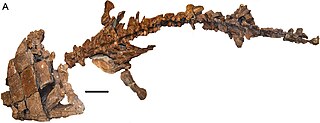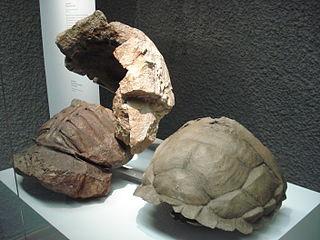
Cynognathus is an extinct genus of large-bodied cynodontian therapsids that lived in the Middle Triassic. It is known from a single species, Cynognathus crateronotus. Cynognathus was a predator closely related to mammals and had a southern hemispheric distribution. Fossils have so far been recovered from South Africa, Argentina, Antarctica, and Namibia.

Lystrosaurus is an extinct genus of herbivorous dicynodont therapsids from the late Permian and Early Triassic epochs. It lived in what is now Antarctica, India, China, Mongolia, European Russia and South Africa. Four to six species are currently recognized, although from the 1930s to 1970s the number of species was thought to be much higher. They ranged in size from that of a small dog to 8 feet long.

Proganochelys is a genus of extinct, primitive stem-turtle. Proganochelys was named by Georg Baur in 1887 as the oldest turtle in existence at the time. The name Proganochelys comes from the Greek word ganos meaning 'brightness', combined with prefix pro, 'before', and Greek base chelys meaning 'turtle'. Proganochelys is believed to have been around 1 meter in size and herbivorous in nature. Proganochelys was known as the most primitive stem-turtle for over a century, until the novel discovery of Odontochelys in 2008. Odontochelys and Proganochelys share unique primitive features that are not found in Casichelydia, such as teeth on the pterygoid and vomer and a plate-like coracoid.

Hyperodapedon is an extinct genus of rhynchosaur reptiles which lived during Late Triassic period. Like other rhynchosaurs, it was an heavily built archosauromorph, distantly related to archosaurs such as crocodilians and dinosaurs. Hyperodapedon in particular was part of the subfamily Hyperodapedontinae, a specialized rhynchosaurian subgroup with broad skulls, beaked snouts, and crushing tooth plates on the roof of the mouth.

Gerrothorax is an extinct genus of temnospondyl amphibian from the Triassic period of Greenland, Germany, Poland, Sweden, and possibly Thailand. It is known from a single species, G. pulcherrimus, although several other species such as G. pustuloglomeratus have been named in the past.

Proterochampsa is an extinct genus of proterochampsid archosauriform from the Late Triassic of South America. The genus is the namesake of the family Proterochampsidae, and the broader clade Proterochampsia. Like other proterochampsids, Proterochampsa are quadruped tetrapods superficially similar in appearance to modern crocodiles, although the two groups are not closely related. Proterochampsids can be distinguished from other related archosauriformes by characters such as a dorsoventrally flattened, triangular skull with a long, narrow snout at the anterior end and that expands transversally at the posterior end, asymmetric feet, and a lack of postfrontal bones in the skull, with the nares located near the midline. Proterochampsa is additionally defined by characters of dermal sculpturing consisting of nodular protuberances on the skull, antorbital fenestrae facing dorsally, and a restricted antorbital fossa on the maxilla. The genus comprises two known species: Proterochampsa barrionuevoi and Proterochampsa nodosa. P. barrionuevoi specimens have been discovered in the Ischigualasto Formation in northwestern Argentina, while P. nodosa specimens have been found in the Santa Maria supersequence in southeastern Brazil. The two species are distinct in several characters, including that P. nodosa has larger, more well-developed nodular protuberances, a more gradually narrowing snout, and a higher occiput than P. barrionuevoi. Of the two, P. nodosa is thought to have less derived features than P. barrionuevoi.

Cyclotosaurus is an extinct genus of temnospondyl within the family Mastodonsauridae. It was of great size for an amphibian, had an elongated skull up to 56 cm (22 in).

Siderops is an extinct genus of chigutisaurid temnospondyl from Early Jurassic of Australia, containing the species S. kehli.

Neritopsidae is a family of small sea snails and freshwater snails in the clade Cycloneritimorpha.
Arganasuchus is an extinct genus of "rauisuchian" (loricatan) archosaur. It is known from a single species, Arganasuchus dutuiti. Fossils of this genus have been found in Upper Triassic rocks of the Argana Basin, Morocco. Though its remains were initially referred to Ticinosuchus when discovered during the 1970s, in 2007 it was identified as a distinct genus with unique features of the pubis and maxilla. Arganasuchus also had several anatomical details in common with Batrachotomus, Fasolasuchus, and Postosuchus, though its relations with other loricatans remains unresolved. Arganasuchus is considered a carnivore due to its large, knife-shaped teeth.

Bobasatrania is an extinct genus of prehistoric marine ray-finned fish that survived the Permian-Triassic extinction event. Fossils of Bobasatrania were found in beds of Changhsingian to Ladinian age. It was most speciose during the Early Triassic.
Delphinulopsidae is an extinct taxonomic family of fossil sea snails, marine, gastropod mollusks.

Bobasatraniiformes is an extinct order of durophagous ray-finned fish that existed from the late Permian to the Middle Triassic in both marine and freshwater environments. The order includes two families: Bobasatraniidae, with the genera Bobasatrania, Ebenaqua, and Ecrinesomus, and Dorypteridae, comprising only the genus Dorypterus (monotypy). Bobasatraniiformes had a somewhat global distribution; fossils are found in Africa (Madagascar), Asia (Pakistan), Australia, Europe, and North America.
Koinia is an extinct genus of temnospondyl amphibian from the Late Permian of Russia. It is an archegosauroid in the subfamily Melosaurinae. Koinia was named in 1993 with the description of the type species K. silantjevi, based on fossils that were found in the Ocher Assemblage Zone, near the Vym River in the Komi Republic.
Uralosuchus is an extinct genus of temnospondyl amphibian from the Late Permian of Russia, belonging to the group Archegosauroidea. It is a member of the archegosauroidean subfamily Melosaurinae. Fossils have been found in Orenburg Oblast. Uralosuchus was named in 1993 with the description of the type species U. tverdochlebovae.

Rhaetina is an extinct genus of brachiopods belonging to the family Angustothyrididae.

Proterochersis is an extinct genus of turtle from the Late Triassic period of Europe. It is known from a large number of fossils uncovered in Germany and Poland. The genus was named from fossil remains from Germany in 1913 by Fraas, who recognized two species: P. robusta and P. intermedia. Since then, Szczygielski and Sulej have found that the differences described by Fraas could be the result of intraspecific variation, meaning that P. intermedia are synonymous with P. robusta. They also decided to classify more recent fossil findings from Poland as two new species, P. limendorsa and P. porebensis. A study from 2021 concluded that fossil turtle remains described in 1865 as Chelytherium obscurum are probably synonymous with Proterochersis. Generally, the rules of nomenclature advocate that the oldest taxonomic name should replace more recent ones, but Szczygielski choose to keep the name Proterochersis.













